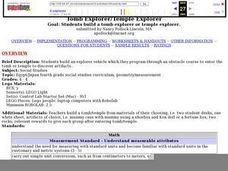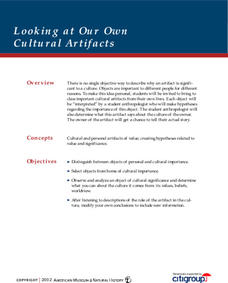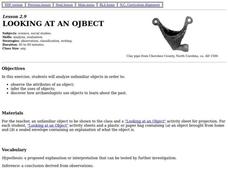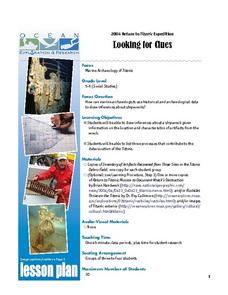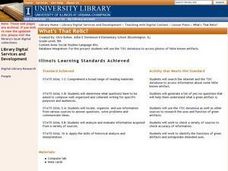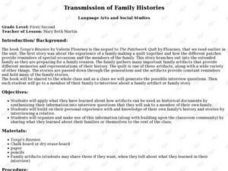Curated OER
Forward March: Continuing Frederick Douglass' Footsteps
Middle schoolers view numerous artifacts from the life of Frederick Douglass. Using the objects, they discover the many parts of his life and develop a hypothesis about the significance of the objects in his life. They identify the...
Curated OER
Artifacts 2: Artifacts in Context
Students will explore an archaeological mystery that demonstrates the importance of context in learning from artifacts. Factors such as the artifact's location, its proximity to other artifacts, and the number of similar artifacts found...
Curated OER
The Ancient Cliff Dwellers of Mesa Verde
Learners research evidence discovered during Mesa Verde archaeological dig, view images of ancient artifacts, simultate real dig and reconstruct items buried on school grounds, and create newsletter or video tape skit.
Curated OER
Social Studies: Aztec Calendars and Culture
Sixth graders analyze the Aztec calendar and create their own examples of them. They determine the meaning of the symbols used in the calendars and record their ideas in journals. Students host a parent breakfast for them to observe...
Curated OER
Second Grade Time Capsules
Second graders leave clues from the past for students of the future by creating time capsules filled with artifacts from the year. These artifacts are buried along with others on school grounds somewhere. Students identify and analyze...
Curated OER
American Prehistory: 8000 Years of Forest Management
Students discuss the first people to live in North America and the types of evidence we have of their existence. They complete a set of worksheets and explore their answer in group discussions.
Curated OER
Buried Treasures
Students, in teams, generate and research questions about Canada's receding glaciers. They then hold a 'press conference' in which each team provides answers for questions in their area of research. Finally, they pool their information...
Curated OER
Searching the Attic
Students conduct field research, including the use of a grid system, in order to discover important or interesting family artifacts.They map discoveries of important artifacts on a grid map in order to track and better analyze...
Curated OER
Introduction of Primary Sources
First graders create two personal artifacts to add to a primary source shoebox that represents information about themselves. The first draw a self-portrait then build an artifact from Play-Doh and pipe cleaners to represent something...
Curated OER
Tomb Explorer/Temple Explorer
Fourth graders build an explorer vehicle which they program through an obstacle course to enter the tomb or temple to discover artifacts.
Curated OER
Artifacts
Students examine different artifacts and determine the difference between personal and cultural objects. They collect items from their home of cultural importance as well. They identify all they can from artifacts they are given to analyze.
Curated OER
Name That Point!
Students compare projectile point attributes, identify and classify points, and match projectile points to a chronology.
Curated OER
Looking At An Object
Young scholars observe the attributes of an object, infer their uses, and discover how archaeologists use objects to explore the past.
Curated OER
Titanic: Looking for Clues
Students make inferences about a shipwreck based on the location of artifacts. They role play as marine archaeologists and list three processes that contribute to the deterioration of the Titanic.
Curated OER
Stones, Bones & Telephones: Analyzing Artifacts Using Bloom's Taxonomy
Seventh graders define metacognition, Bloom's Taxonomy, and artifacts. They, in groups, try to identify a mystery artifact using the Artifact Analysis sheet. They present their findings to the class.
Curated OER
"Dig It"
Twelfth graders explore Native American Mounds in Ohio to identify their purpose and methods of creation. A variety of learning stations are provided.
Curated OER
Quilting Our Communities
Students share personal artifacts and use them to make a classroom community quilt.
Curated OER
Re-covering Imperial History
Young scholars read about imperialism in Japan and China and write their own book based on the story they read.
Curated OER
Intrigue of the Past: North Carolina's First Peoples
Young scholars study the archeological history of North Carolina in this series of lessons.
Curated OER
BIRDS OF A FEATHER
Students observe and identify characteristics of artifacts and fossils; explain how artifacts and fossils are used to explore the past; and identify ways that Native Americans prepared food and made tools
Curated OER
What's That Relic?
Fifth graders listen to a read aloud of David Mc Cauley's book Motel of the Mysteries. They discuss an unknown artifact and decide what it might be used for. They research other artifacts and play "What's that Relic?"
Curated OER
Transmission of Family Histories
Students examine how different artifacts represent family history, stories, and experiences. They act as reporters for their own family artifacts sharing them with the class.
Curated OER
Archaeology
Students explore purpose and process of archaeology, as well as demonstrate how it applies to their own lives, through a simulated archaeological dig.
Curated OER
Creating an Autobiographical Amulet Necklace
Students create their own personalized amulet necklaces after viewing images of artifacts from different cultures.









